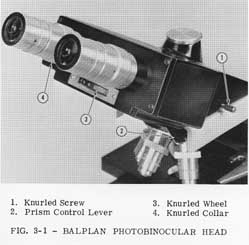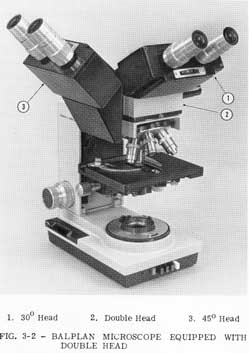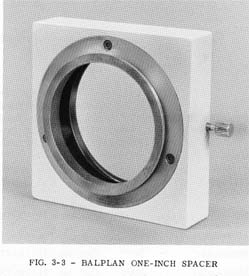
Heads are directly interchangeable on the Microscope Stand. The Heads are designed for use with Bausch & Lomb Flat Field Objectives. They are rotatable through 360°. A Clamp Screw, Fig. 3-1, permits locking the Head at any point in its 360° rotation.
Head types include:
* Eyepiece inclination angle from the horizontal.

To set the Eyepiece Tubes of the Binocular Head for the proper interpupillary distance, rotate the Knurled Wheel, Fig. 3-1, to the desired distance as indicated on the interpupillary scale. To determine your interpupillary distance setting, adjust the Eyepieces together or apart, using the Knurled Wheel, until you are seeing the full field of view with both eyes. Check this by closing one eye and then the other without moving your head. After you have found the proper setting, record or remember it for future use.
As you adjust the interpupillary distance, the tube length remains constant. The effect of this is that there is no change in objective parfocality and no change in magnification. Measuring Eyepieces that have been calibrated remain in calibration for all interpupillary distances.
The left Eyepiece Tube is individually focusable by means of the Knurled Collar, Fig. 3-1, so that equally sharp images on both the left and right side may be attained.
To set them for your eyes, it is recommended that you use the lowest
power Objective since the setting is most sensitive in this case.
Focus the Microscope until the right image appears sharp to your right
eye. Then, without changing the focus adjustment, adjust the left
Eyepiece until the image appears sharp in your left eye.
The Microscope is now adjusted properly for your eyes.

The Photobinocular Head, Cat. No. 311879, is intended for photomicrographic use and has a movable Prism which directs all of the illumination to either the Camera for photomicrography or to the inclined Eye-pieces for visual use. Push the Prism Control Lever, Fig. 3-1, away from you for visual use, and to switch from Visual to Camera use, move the Prism Control Lever toward you until it comes to a stop.
A One Inch Spacer, Cat. No. 31-18-92, is available if it is desired
to raise the eyepoint of the various Heads, Fig. 3-3.

The 30° Binocular Head, Cat. No. 31-18-77, and the 45° Head, Cat. No. 31-18-91, are used with the Double Head, Cat. No. 31-18-93, to provide dual viewing of a specimen, Fig. 3-2. The 30° Binocular Head should be used at the operator's position and the 45° Binocular Head should be used at the observer's position. This results in a more comfortable eyepoint position for the observer.